How to Hack a Table Lamp?
This project is about hacking a Table Lamp to extend or disable the integrated Auto-Shutoff.
This project is about hacking a Table Lamp to extend or disable the integrated Auto-Shutoff.
To make the experience fit your profile, pick a username and tell us what interests you.
We found and based on your interests.
MSP430-Barebone.schEagle Schematic of the MSP430 Breakout Boardsch - 329.27 kB - 02/20/2019 at 20:22 |
|
|
MSP430-Barebone.brdEagle Boarddesign of the MSP430 Breakout Boardbrd - 89.68 kB - 02/20/2019 at 20:22 |
|
|
LowPowerSwitch.inoFirst Sketch I used to "hack" the lampino - 1.34 kB - 02/14/2019 at 20:31 |
|
Finally all Lamps are modified according to the specifications ;-)
Lets see if there are further changes needed ;)
Thank you for bearing with me.
Finally i got some time to rework the Table Lamps. Since i got a not so specific PCB it was only a small effort.
Regarding the Assembly… It was really fast forward – only like 0,5h per PCB. An Advantage was that there are only 6 SMD components and one Jumperrow.
I also already tested the PCB and it worked! I didn’t really expect it but I appreciate it. Next Step is integration into the Lamp.
I ordered the PCBs via JLC PCB on 2019-02-15. They might have been delivered yesterday - but unfortunately, I wasn't at home...
Next Time I have to pay attention to not order more than 22€ ... so that in Germany there will be no taxes. And also need to pay attention, that the DHL Express doesn't take care of customs. Please note this if you consider to order 😉
Regarding the prices:
10 pcs = €1.78
+ Shipping Charge: €16.14
+ Customs €22,51
I also ordered some more Stuff at the LCSC.COM and an other PCB. If you balance your Order a bit better, I think it is a great resource for custom pcbs.
At the purple Company 9 pcs = $14,40 with free shipping. Considering the “Shipping Charge” and Taxes It is not a big gap.
Just as promised i finally received the PCBs.
To realize the "Hack" for 5 lamps i just did a small PCB Design which should be sufficient to cover this project on a budget.
The Schematic is in General only a Breakout for the MSP430G2231EP. Therefore i call it the MSP430 Barebone PCB. I added a DC Converter for the µC and 3 Outputs which may feature a BC817 NPN Transistor:

There are also some emty Pads because of having is better than needing ;-)
This is how the Desing looked like in Eagle :-)
They also promised, that it will arrive this week ^^ (It is already shipping) Stay tuned.
As I had luckily a MSP430 Launchpad and a custom MSP430 Breakout board laying around i thought I should give this one a Try. With the help of the Internet I created a really simple program.
Its a really small programm. I added it to the project.
Here is a quick schematic (I added some circles on the attachement points to the lamp):
This circuit has a sleep current of ~ 4.5µA. (So i get hypothetically >60 years of Battery life. Since it is really likely, that the lamp might be on > 60h in the next 60 Years, it is a ok tradeoff (don't take the self discharge in account). The µC is capable of sleeping at ~ 0,5µA but the voltage regulator has a 3,3µA Quiscent Supply Current.
Here you can find a proof of concept (150x Speed):
I thought about the Battery Life... If i assume that one cell holds 800mAh, 3 Cells hold 2400mAh.
So if the circuit draws 100µA the batteries would last 1.000 days???
So if the circuit draws 10µA the batteries would last 10.000 days (>27 Years) ???
If the circuit draws 100mA the batteries would last only 24h???
I'm still a bit sad, that the original Circuit draws 0.0µA ... so the batteries would last infinitely :-D...
The completed Project should fulfill the following Requirements:
From first view a lovely table lamp. But it is also very annoying, that it shuts down after only 15 Minutes.
I checked all components on the PCB:
So the U1 is a "black box" there is AFAIK not much to do with the existing pcb.
The "Sleep Current" is about < 0,2µA @ 4,8V.

So there are some possible solutions:
* Maybe there would be a possibility to enable the Power only after press of the Button?.. if not it would definitely break the energy rating (Battery Life).
I'm still open for further Ideas. Please let me know in the comments.
Create an account to leave a comment. Already have an account? Log In.
@Miklos Marton : Thank you for your comment. One restraint was to keep the Lamp unharmed on the outside ;-) But the micro USB port came also to my mind :-D
I also thought about chaining the lamps... but was also outside of scope ;-)
Become a member to follow this project and never miss any updates

 makeTVee
makeTVee
 Open Green Energy
Open Green Energy
 Adam Gulyas
Adam Gulyas
 Dillon Nichols
Dillon Nichols
Haha, I also came across the same problem, but used a simpler solution: a switch.
I also noticed that the LED sinks ~130mA, so I looked for other alternative powering methods: I added a micro USB port to the side.
I wanted to maintain the battery operation so I came up with a circuit which automatically switches between USB and battery powered operation without sacrificing power drop on diodes and accidental charging from battery.
I did it on a test board with wire soldering, and unfortunately I have not taken any pictures.
I only have an LTSpice simulation screenshot in the case if anyone is interested in the solution:
https://i.imgur.com/3gC9Kxs.png